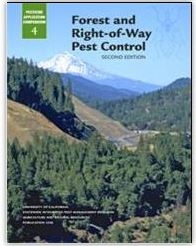Information on managing invasive weeds and other pests available in new edition of Forest and Right-of-Way Pest Control
Brooms are shrubs introduced into North America from Europe in the mid-1800s. Common species include Scotch broom (Cytisus scoparius) and Portuguese broom (Cytisus striatus). Brooms initially were introduced as ornamentals, but then used extensively for erosion control along roadsides and in mined areas.
Now throughout California forests, roadsides, and wildlands they are weeds that increase the risk of wildfire and crowd out desirable vegetation. They form impenetrable thickets that invade other vegetation, shade out tree seedlings, and make reforestation difficult. They burn readily, increase the intensity of fire, and carry fire to the tree canopy. They are toxic to cattle and horses and unpalatable to most wildlife. Brooms produce abundant, long-lived seed and are able to fix atmospheric nitrogen, giving them competitive advantage over native plants.

Invasive species that create a dangerous wildfire hazard and crowd out desirable vegetation and wildlife are examples of why this book emphasizes vegetation management and pesticide handling, including correct equipment calibration and effective herbicide application. The second edition also provides broader coverage of insects, plant pathogens, vertebrate pests, and the various practices to manage them, recognizing that lands commonly have multiple uses and when and how pests are managed depends on many considerations with sometimes conflicting goals.
Experts with Cal-Fire, Caltrans, PG&E, USDA Forest Service, private industry, the University of California (UC) Berkeley and Davis campuses, UC County Cooperative Extension offices, and the California Department of Pesticide Regulation (DPR) contributed to Forest and Right-of-Way Pest Control, prepared by UC ANR's Statewide Integrated Pest Management Program.
Forest and Right-of-Way Pest Control is available for $35 online in the UC ANR Catalog. The table of contents and more information about the book are available on the UC IPM website. You can also preview and electronically search the contents on Google Books.